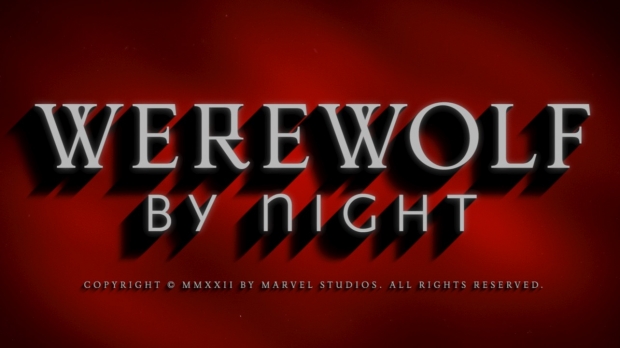For multi-award-winning composer Michael Giacchino’s directorial debut, the cross-media production company’s creative team embraced the director’s vision and dedication to classical aesthetics, capturing the stylized look and feel of a classic horror film from the 1930s-1940s.
Multi-award-winning composer Michael Giacchino recently tasked cross-media production company, Sarofsky, to create the opening and main-on-end title sequences for his directorial debut, Marvel Studios Special Presentation, Werewolf by Night. The special, starring Gael García Bernal, Laura Donnelly, Harriet Sansom Harris, and Eugenie Bondurant, is now streaming on Disney+.
“I absolutely loved working with Sarofsky on Werewolf by Night,” began Giacchino. “During production, I prioritized practical effects as much as possible, and when we started in post, Sarofsky fully embraced that approach. The shots they created (many crafted physically and then photographed) are stunning, and they were fantastic collaborators.”
“Our assignment began with a brilliant and thorough explanation of a distinct vision for the film and its titles by Michael himself,” explained executive creative director Erin Sarofsky. “Much more than a film about a werewolf, this is also the introduction of monsters to the Marvel Cinematic Universe.”
With extensive hands-on involvement by post-production supervisor Tristan Mathews, film editor Jeffrey Ford, and co-executive producer Brian Gay, the creative team captured the stylized look and feel of a classic horror film from the 1930s - 1940s with a dedication to classical aesthetics and techniques.
In the opening sequence, the team established the story’s unique universe, drawing the audience into the how and why behind the story’s starting point. Sarofsky created a series of illustrations for this animated sequence to match the story’s narration. Longtime studio collaborator Tricia Kleinot nailed a style fit for a glass museum case with her intricate sketches inspired by old etchings and scientific studies. Brought into After Effects, animated, and timed out to a reference edit, the story comes to life visually, then transitions back to live-action, using the waxing gibbous moon as a connecting element.
“Knowing this needed to be dark, mysterious, and somewhat sinister, we set out to heighten the vintage look and embrace the imperfections of something made by hand,” noted Sarofsky. “As if by fate, we reconnected with Javier Rodriguez Garcia (Lobulo), a specialist in the art of papercraft, just in time to invite him onboard for this project.”
Watch the opening sequence for Werewolf by Night:
Later, at the film’s conclusion, the main-on-end sequence allowed the filmmakers to dramatically illuminate the unique MCU domain where monsters and their hunters collide.
This finished 106-second sequence features blood-red color over black, using iconic and novel horror glyphs in silhouette, highlighted by outlines of color that graduate into darkness. Titles appear in white with typography in the Priori typeface (inspired by old street signage and lettering from London neighborhoods), ultimately resolving into the Werewolf by Night logo designed by Andrei Popa.
The creation of the 20 featured glyphs took physical form as a “mini-set” shadowbox containing 20 or more individual layers of cut-out paper, then intricately lit and filmed in Sarofsky’s studio in partnership with director of photography Mike Bove.
The “prep” for filming the glyphs involved a workflow that informed key decisions and client discussions before cutting paper and building the mini-sets. In addition, to dial-in factors, including ideal scale, lenses, and camera speed, the main-on-end sequence was previsualized using Maxon C4D.
Created in Adobe Illustrator, the illustration’s layers were imported into C4D, extruded, and placed in 3D space. Once the look was right, each scene was exported in wireframe mode and brought into Adobe Premiere. for editing by Sarofsky and senior editor Tom Pastorelle to the music track.
“In this phase, each scene was boarded out and then put into an edit where I would play with movement and timing,” explained Pastorelle. “That influenced the next stage, where our design team started animating the boards. We met with Michael Giacchino and Jeffrey Ford. As a musician and also the film’s composer, naturally, Michael was especially invested in how our sequence hit on certain beats.”
With approvals and further experimentation and research by Bove, live-action production began with a Red Ranger Helium for principal photography, filming in 8K resolution and using a motorized slider for consistent speed. Also equipped with a variety of lenses for maximizing depth of field and parallax, Bove and Sarofsky’s creatives set out to experiment on set with light placement, movement, and flickering.
Describing the project as “deceptively tricky,” Bove shared, “We were shooting small objects very close with a repeatable camera move. Achieving the depth of field needed at such close distances required a deep F-stop, and we were mostly lighting through thick paper, so we tested out a bunch of different types of lighting fixtures before the actual shoot days.”
Continued Bove, “In the end, it came down to something pretty old school: Mole Richardson tungsten fresnels. We could get these fixtures close enough to the shadow box to achieve the levels we needed, and also, the focusability and crispness of the light beam really helped bring out the texture of the paper when lit through the sides or the top. The boxes themselves were so beautiful – every time a new one came to set, we had to stop everything to admire it. Javier did an outstanding job.”
From there, the studio’s finishing workflow involved minimal post, mainly consisting of minor clean-up and lighting tweaks, which allowed them to finish in Adobe After Effects. Since Sarofsky’s deliverables needed to conform with the Marvel VFX workflow, those precise delivery specifications, including naming conventions and color pipeline, were adhered to strictly.
“This piece was a direct result of Duarte's passion, vision, and craftsmanship,” said Sarofsky. “He is an amazing creative with the ability to listen, lead, and ultimately follow through. Watching him and Michael mind meld was one of the most rewarding parts of the process. I am so thrilled with the outcome!”
Watch the main-on-end title sequence for Werewolf by Night:
Source: Sarofsky













